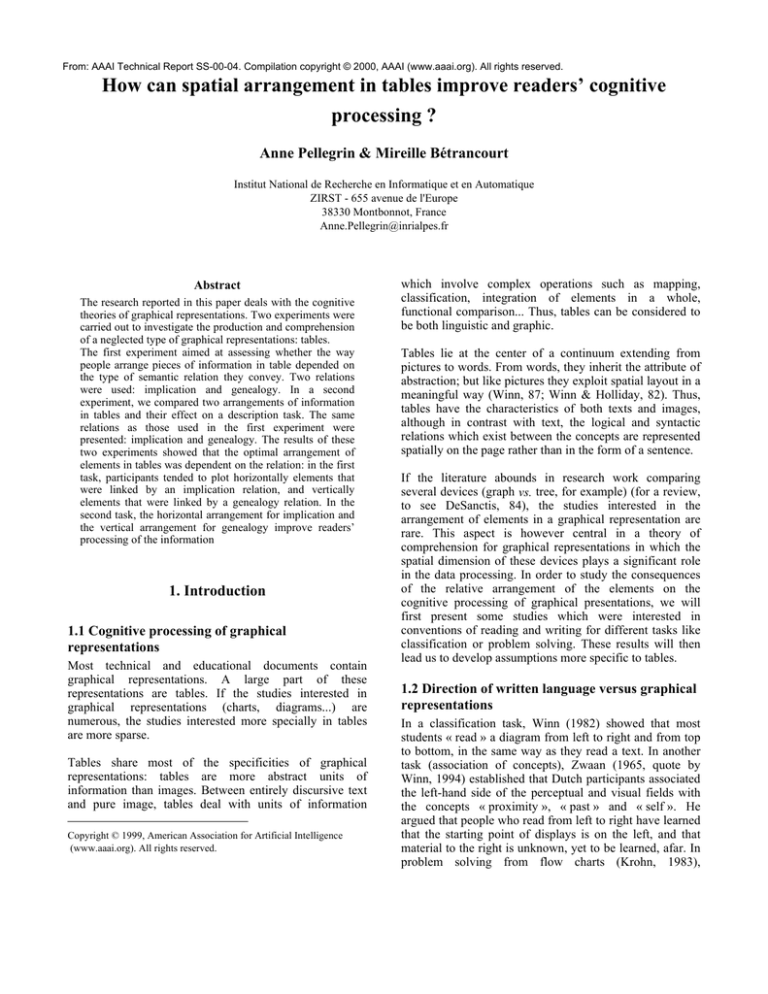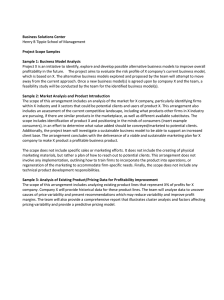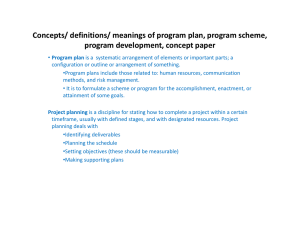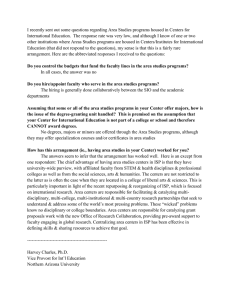
From: AAAI Technical Report SS-00-04. Compilation copyright © 2000, AAAI (www.aaai.org). All rights reserved.
How can spatial arrangement in tables improve readers’ cognitive
processing ?
Anne Pellegrin & Mireille Bétrancourt
Institut National de Recherche en Informatique et en Automatique
ZIRST - 655 avenue de l'Europe
38330 Montbonnot, France
Anne.Pellegrin@inrialpes.fr
Abstract
The research reported in this paper deals with the cognitive
theories of graphical representations. Two experiments were
carried out to investigate the production and comprehension
of a neglected type of graphical representations: tables.
The first experiment aimed at assessing whether the way
people arrange pieces of information in table depended on
the type of semantic relation they convey. Two relations
were used: implication and genealogy. In a second
experiment, we compared two arrangements of information
in tables and their effect on a description task. The same
relations as those used in the first experiment were
presented: implication and genealogy. The results of these
two experiments showed that the optimal arrangement of
elements in tables was dependent on the relation: in the first
task, participants tended to plot horizontally elements that
were linked by an implication relation, and vertically
elements that were linked by a genealogy relation. In the
second task, the horizontal arrangement for implication and
the vertical arrangement for genealogy improve readers’
processing of the information
1. Introduction
1.1 Cognitive processing of graphical
representations
Most technical and educational documents contain
graphical representations. A large part of these
representations are tables. If the studies interested in
graphical representations (charts, diagrams...) are
numerous, the studies interested more specially in tables
are more sparse.
Tables share most of the specificities of graphical
representations: tables are more abstract units of
information than images. Between entirely discursive text
and pure image, tables deal with units of information
Copyright © 1999, American Association for Artificial Intelligence
(www.aaai.org). All rights reserved.
which involve complex operations such as mapping,
classification, integration of elements in a whole,
functional comparison... Thus, tables can be considered to
be both linguistic and graphic.
Tables lie at the center of a continuum extending from
pictures to words. From words, they inherit the attribute of
abstraction; but like pictures they exploit spatial layout in a
meaningful way (Winn, 87; Winn & Holliday, 82). Thus,
tables have the characteristics of both texts and images,
although in contrast with text, the logical and syntactic
relations which exist between the concepts are represented
spatially on the page rather than in the form of a sentence.
If the literature abounds in research work comparing
several devices (graph vs. tree, for example) (for a review,
to see DeSanctis, 84), the studies interested in the
arrangement of elements in a graphical representation are
rare. This aspect is however central in a theory of
comprehension for graphical representations in which the
spatial dimension of these devices plays a significant role
in the data processing. In order to study the consequences
of the relative arrangement of the elements on the
cognitive processing of graphical presentations, we will
first present some studies which were interested in
conventions of reading and writing for different tasks like
classification or problem solving. These results will then
lead us to develop assumptions more specific to tables.
1.2 Direction of written language versus graphical
representations
In a classification task, Winn (1982) showed that most
students « read » a diagram from left to right and from top
to bottom, in the same way as they read a text. In another
task (association of concepts), Zwaan (1965, quote by
Winn, 1994) established that Dutch participants associated
the left-hand side of the perceptual and visual fields with
the concepts « proximity », « past » and « self ». He
argued that people who read from left to right have learned
that the starting point of displays is on the left, and that
material to the right is unknown, yet to be learned, afar. In
problem solving from flow charts (Krohn, 1983),
participants who studied flow charts oriented from left to
right made fewer errors and were faster to read the flow
chart and to solve the problems, than the participants who
used the flow charts oriented from right to left.
Tversky, Kugelmass & Winter (1991) studied the way
children from three language cultures, English, Hebrew,
and Arabic, produced graphical representations of spatial,
temporal, quantitative, and preference relations. Children
had to place stickers on square pieces of paper to represent,
for example, a disliked food, a liked food, and a favorite
food. The analysis of directionality of the represented
relation showed effects of direction of written language
only for representations of temporal concepts: left-to-right
was dominant for English speakers whereas right-to-left
was dominant for Arabic speakers, with Hebrew speakers
in between.
The results of these studies lead us to formulate the
following question: are the results on the influence of
direction of written language applicable to the reading of
table? In other words, is it possible to define a preferred
arrangement in tables ?
on the same piece of paper.
In order to avoid any bias related to the arrangement of
words in the sentence, the texts were presented in three
different forms according to the control factor « Sentence
form » (Between-subjects factor). The first group of
participants saw the texts in the form « 1 object 2
attributes », the second group of participants saw the texts
in the form « 2 objects 1 attribute » and the third group of
participants saw the texts in the form « Reversed
Relation » (see Table 1 and Table 2). Every participant saw
the two relations (within-subjects factor).
Table 1: Control Factor « Sentence Form »: Example of
sentence given to participants for the relation of
Implication
1 object (Antilles)
2 attributes (Climate and
Tourism)
2 objects (Antilles and
Island)
1 attribute (Climate)
Reversed relation (because)
2. Experiment 1
The objective of this first experiment was to determine
whether people use a spontaneous arrangement to plot
information in tables as a function of the semantic relation
that is expressed. We used two relations: implication and
genealogy.
For implication, previous research has provided evidence
that participants preferentially arranged the elements of the
relation horizontally, with the element « cause » plotted on
the left of the element « effect » (Tversky et al., 91).
For genealogy, it was shown that participants preferentially
arranged the elements of the relation vertically, with the
element « father » plotted on the top of the element « son »
(like in a family tree, which is a more common
representation to display relation of filiation).
We expected that these preferred directions would apply to
tables.
2.1 Method
Participants
Thirty participants, 17 male and 13 female, were
individually tested. All of them were graduated and the
average age was 29,2 years. All participants were native
French-speakers.
Material
The material consisted of 8 texts involving 4 relations of
implication and 4 relations of genealogy.
Each text was written on a piece of paper and for each
relation, an empty table (3 rows * 3 columns) was drawn
In Antilles, the climate is hot
and the tourism is abundant.
In Antilles, the climate is hot
and in Island the climate is
cold.
In Antilles, the tourism is
abundant because of a hot
climate.
Table 2: Control Factor « Sentence Form »: Example of
sentence given to participants for the relation of Genealogy
1 object (Dupont Family)
2 attributes (Father and
Son)
2 objects (Dupont Family
and Durand Family)
1 attribute (Father)
Reversed relation
In Dupont Family, the father
is named Georges and the son
is named Théophile.
In Dupont Family, the father
is named Georges and in
Durand Family, the father is
named Albert.
In Dupont family, the son is
named Theophile and the
father is named Georges.
Procedure
The participants were randomly assigned to three
independent groups, according to each modality of the
control factor. In all groups, participants were tested
individually and received the same explanations. All texts
were given to the participants in a leaflet. They were told
to read the text and then plot the elements of the relation in
the table. They could not go to next page before
completing the table in the previous page.
2.2 Results
Since the factor « Sentence form » had no effect, the
results were collapsed across the three groups.
Table 3 presents the proportion of participants who plotted
horizontally and vertically the elements of the relations.
Table 3: Proportion of participants who plotted
horizontally and vertically the elements of the relations.
Horizontal
Arrangement
Vertical
Arrangement
Implication
61 %
Genealogy
42 %
39 %
58 %
descriptions. The task « Description to make the addressee
understand the table » requires the participants to
understand the relations expressed between the elements of
the table (without necessarily taking into account the
spatial arrangement of the elements).
3.1 Method
Participants tended to plot implication horizontally (see
Table 4) whereas they tended to plot genealogy vertically
(see Table 5). A Chi square analysis computed on the
number of participants who used each direction to
construct the table, showed that the effect of the type of
relation was statistically significant (χ2 = 8,822; p < .01).
Table 4: Relation of Implication plotted horizontally by a
participant
Antilles
Island
Climate
Hot
Cold
Tourism
Abundant
Rare
Table 5: Relation of Genealogy plotted vertically by a
participant
Father
Son
Dupont Family
Georges
Théophile
Durand Family
Albert
Rémi
Material
In this second experiment, we used the same relations as in
the first experiment (implication and genealogy). For each
relation, we compared two arrangements: the Usual
arrangement, i.e. the direction which was preferentially
used by the participants in the first experiment and an
Unusual arrangement. The material consisted of two tables
involving implication and genealogy. The relations were
presented on the screen using Hypercard software.
For implication, in the Usual arrangement the two terms of
the relations were plotted horizontally. Conversely, in the
Unusual arrangement the two terms of the relations were
plotted vertically (see Table 6).
Table 6 : Usual (6a) and Unusual (6b) arrangement for the
relation of Implication
6a : Usual arrangement
2.3 Discussion
The results of this first experiment showed that participants
tended to plot horizontally elements that were linked by an
implication relation, whereas we found a slight tendency to
plot genealogy vertically. On the basis of these results, we
considered the horizontal arrangement as the usual
arrangement for implication and the vertical arrangement
as the usual arrangement for genealogy.
3. Experiment 2
The objective of this second experiment was to study the
effects of the relative arrangement of the elements in a
table in a description task. We assumed that the spatial
arrangement of information in a table influences the
readers’ cognitive processing.
Therefore we expected that the strategies of descriptions
used by the participants would be influenced by the
arrangement of the elements in the table. Indeed, Winn
(1982, 1983) and Wright & Reid (1973) showed that the
way information was presented inside a chart (tables, tree
structures) influenced the cognitive processing of
information.
Two types of tasks were used: « Description to make the
addressee reproduce the table » and « Description to make
the addressee understand the table ». The task
« Description to make the addressee reproduce the table »
requires the participants to take into account the
arrangement of the elements in the table to organize their
Antilles
Island
Climate
Hot
Cold
Tourism
Abundant
Rare
6b : Unusual arrangement
Climate
Tourism
Antilles
Hot
Abundant
Island
Cold
Rare
For genealogy, in the Usual arrangement the two terms of
the relations were plotted vertically. Conversely, in the
Unusual arrangement the two terms of the relations were
plotted horizontally (see Table 7).
Table 7 : Usual (7a) and Unusual (7b) arrangement for the
relation of Genealogy
7a : Usual arrangement
Father
Son
Dupont Family
Georges
Théophile
Durand Family
Albert
Rémi
7b : Unusual arrangement
Dupont Family
Durand Family
Father
Georges
Albert
Son
Théophile
Rémi
Participants
Forty participants, 17 male and 23 female, were
individually tested. All of them were graduated and the
average age was 27,2 years. All participants were native
French-speakers. All were right-handed and had
experience of using a computer mouse.
« Hierarchical ».
Procedure
The procedure involved two phases. After reading the
instructions, a training task for using the consultation
device was proposed to the participants. For each relation,
the participants had to produce a written description of the
information contained in the table either for reproduction
or for comprehension according to the condition. To
consult the table, the participants pressed the button of the
mouse to maintain the table on the screen. As soon as the
participants released the button of the mouse, the table
disappeared. The participants consulted the table as many
times as they needed. However, they could write their
description only after they had released the mouse button.
The consultation was identical for each table. In the second
phase, the experimenter explained the participants that they
had to re-examine these same presentations in order to
produce a description to make the addressee understand the
table. And conversely for the participants having started
with the task « Description to make the addressee
understand the table ». The two relations Implication and
Genealogy were presented in the same order for all the
participants.
Example of hierarchical description generated by a
participant:
Design
Every participants saw the two relations and performed the
two tasks (within-subjects factors). Half of the participants
began with the task « Description to make the addressee
reproduce the table » and the other half began with the task
« Description to make the addressee understand the table ».
The first 20 participants do the experiment with the tables
presented in the Usual arrangement and the next 20
participants, with the tables presented in the Unusual
arrangement.
The design was a factorial design using the type of task
(description for reproduction and description for
comprehension) and the type of relation (implication vs.
genealogy) as the within-subjects factors, and two
between-subjects factors: the Arrangement (usual vs. non
usual) and the Order of task (control factor with two
modalities).
3.2 Results of the task « Description to make the
addressee reproduce the table »
Analysis of verbal protocols according to the strategies
of description
The descriptions produced by the participants for these two
relations were divided into two categories: descriptions
dependent on the syntax of the table and descriptions
independent of the syntax.
• In the first type of description, the table is decomposed
in sectors, that are determined by the significant elements
of the table.
These three elements are row heading, columns heading
and intersections. The differences between participants’
descriptions depended on the order in which these three
elements were described. We called this strategy
A table 2 columns * 2 rows. The columns headings
are Antilles, Island, the row headings are Climate and
Tourism. The cell Antilles / Climate contains Hot.
The cell Antilles / Tourism contains Abundant. The
cell Island / Climate contains Cold. The cell Island /
Tourism contains Rare.
• In the second type of description, the table is described
row by row or column by column.
The differences between participants’ descriptions
depended on the order the three lines or columns were
described. We called this strategy « Linear ».
Example of linear description generated by a participant:
The objective is to reproduce the contents of a table
made with 3 lines and 3 columns. On the first line, the
column 1 is empty, the second contains the word "
Antilles ", the third " Island ". On the second line, we
find successively the word (one by cell) " Climate ", "
Hot " and " Cold ". Lastly, on the third line, we find
the word " Tourism ", " Abundant " and " Rare ".
Table 8 presents the number of hierarchical and linear
Strategies according to the arrangement.
Table 8: Percent of hierarchical and linear Strategies
Hierar.
Linear
Usual Arrangement
Implic.
Genea.
75 %
80 %
25 %
20 %
Unusual Arrangement
Implic.
Genea.
55 %
55 %
45 %
45 %
For the two relations, the hierarchical strategies
outnumbered the linear strategies overall, regardless of the
arrangement (Usual or Unusual). However, when the
arrangement was Unusual, participants used more linear
description strategies than when the arrangement was
Usual. The distribution of hierarchical and linear
description strategies was statistically different from
chance when the arrangement was Usual : Implication (χ2
(1) = 5 ; p < . 05) and Genealogy (χ2 (1) = 7,2 ; p < .01).
As hierarchical strategies are more elaborated than linear,
the results show that usual arrangement induced
participants to make a more elaborated description
compared to the unusual arrangement.
3.3 Results of the task « Description to make the
addressee understand the table »
Participants’ descriptions were analyzed using the
integration level model of Scardamalia (1981).
Scardamalia established four levels of integration which
correspond to a progression from the absence of relation
between the four units of table (level 1) to a complete
interrelationship between the four units of the table (level
4). For each relation, we detail here, the levels of
integration of the written productions of the participants. In
table 9, we gathered levels 1 and 2 as low levels of
integration and levels 3 and 4 as high levels of integration.
Table 9: Integration levels for each arrangement
Usual Arrangement
Implic.
Genea.
Levels 1+2 40 %
55 %
Levels 3+4 60 %
45 %
Unusual Arrangement
Implic.
Genea.
70 %
90 %
30 %
10 %
For both relations, we observed more highly integrative
descriptions (level 3 + 4) when the arrangement was the
usual one. A Chi square analysis computed on the number
of participants showed that the effect of Arrangement was
statistically significant for genealogy (χ2 (1) = 6,144 ; p < .
05). For implication (χ2 (1) = 3,636 ; p = .0565), we
accept the significance of the difference at this level.
3.4 Discussion
The results of this second experiment showed that
participants’ descriptions were influenced by the way the
relation was plotted in the table. In the description for
reproduction task, we found more elaborated description
when the arrangement was usual than when the
arrangement was unusual. In the description for
understanding task, the level of integration was higher
when the arrangement was usual.
4. General Discussion
Two experiments were carried out in order to investigate
how the spatial arrangement of information in tables
affects readers’ cognitive processes. The first experiment
was designed to assess whether the spontaneous
arrangement depended on the kind of relations between
elements in the table cells. Results showed that participants
tended to plot horizontally elements that were linked by an
implication relation, and vertically elements that were
linked by a genealogy relation. Therefore, it was assumed
that people expected horizontal arrangement for
implication, and vertical arrangement for genealogy. The
second experiment investigated the effect of arrangement
(horizontal vs. vertical) on the strategies used to describe
the table, either to have it reproduced, or to make the
addressee understand. In the description for reproduction
task, the proportion of participants that used a hierarchical
strategy over a linear one was higher when the
arrangement was expected (i.e. horizontal for implication
and vertical for genealogy). In the description for
understanding task, we found a higher level of description
complexity with an expected arrangement.
These findings suggest that people expect a specific
arrangement according to the relation that is plotted in the
table (i.e. horizontal for implication, and vertical for
genealogy). Consequently, plotting information in the
expected way improves readers’ processing of the
information. This finding is consistent with the hypothesis
that processing of graphics is based on cognitive natural
way of using space to convey meaning (Zacks & Tversky,
1999). As a consequence, graphics that are designed
according to the principles of cognitive naturalness are
easier to process and interpret. Further research is in
progress to assess this hypothesis in a problem solving task
using eye-movement recording. Future avenues for
research will investigate the natural way of displaying
information for the most usual types of information that
can be found in tables.
From a practical point of view, this research suggests
helpful hints for the design of tables in educational or
technical documents. The findings particularly apply to
specify computerized systems in which tables can be
automatically generated from plain text. Since it is well
known that readers experience difficulties in understanding
complex graphical representations (tables, flow charts, and
so on), research must be done to provide designers with
guidelines to improve the cognitive relevance of graphics.
For the moment, recent research on tables provides the
following guidelines for arranging information in twodimensional tables :
• Tables are more appropriate when the users have to
recall or identify specific values and lines graph are
more appropriate for identifying and comparing trends
(Meyer, 97).
• Plot the ordered dimension horizontally from left to
right (time, quantity, alphabetical order if no semantics
is available); if both dimensions are ordered, plot the
continuous one horizontally from left to right, and the
discrete dimension vertically from top to bottom.
• Plot the dimensions that are not ordinal according to
the natural order in language (for examples, good/poor
rather than poor/good, singular/plural rather
plural/singular).
7. References
DeSanctis, G. 1984. Computer graphics as decision aids:
Directions for research. Decision Sciences 15:463 - 487.
Krohn, G. S. 1983. Flowcharts Used for Procedural
Instructions. Human Factors 25(5):573-581.
Meyer, J. 1997. A new Look at an Old Study on
Information Display: Washburne (1927) Reconsidered.
Human Factors 39(3):333-340.
Scardamalia, M. 1981. How Children Cope with the
Cognitive Demands of Writing. In C. H. Frederiksen, C.H.
& Dominic J. F. eds. Writing : Process, Development and
Communication (Volume 2). Lawrence Erlbaum
Associates, Hillsdale, New Jersey.
Tversky, B., Kugelmass, S. & Winter, A. 1991. CrossCultural and Developmental Trends in Graphic
Productions. Cognitive Psychology 23:515-557.
Winn, W. 1982. The role of diagrammatic representation in
learning sequences, identification and classification as a
function of verbal and spatial ability. Journal of research
in science teaching 19(1):79-89.
Winn, W. 1983. Perceptual strategies used with flow
diagrams having normal and unanticipated formats.
Perceptual and Motor Skills 57:751-762.
Winn, B. 1987. Charts, Graphs, and Diagrams in
Educational Materials. In Willows, D. M. & H. A.
Houghton, H. A. eds. The Psychology of Ilustration Volume 1: Basic Research (pp 152-198) New York, NY:
Springer-Verlag.
Winn, W. 1994. Contributions of Perceptual and Cognitive
Processes to the Comprehension of Graphics. In Schnotz,
W. & Kulhavy, R. W. eds. Comprehension of Graphics.
(pp. 3 - 27), Amsterdam, The Netherlands: Elsevier
Science BV.
Winn, W. & Holliday, W. 1982. Design Priciples for
Diagrams and Charts. In Jonassen, D. ed., The technology
of Text. (pp 277-299) Vol. 1, Educational Technology
Publications, Englewood Cliffs, New Jersey.
Wright, P. & Reid, F. 1973. Written information : some
alternatives to prose for expressing the outcomes of
complex contingencies. Journal of Applied Psychology
57(2):160-166.
Zacks, J. & Tversky, B. 1999. Bars and lines: A study of
graphic communication. Memory & Cognition 27(6):10731079.
Zwaan, E. W. J. 1965. Links en rechts in waarneming en
beleving. (Left and right in visual perception as a function
of the direction of writing). Ph.D. diss, Rijksuniversiteit
Utrecht, The Netherlands.





